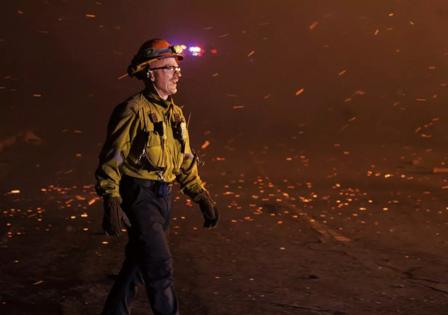Fire marched toward west Altadena hours before official accounts, new report shows
Published in News & Features
LOS ANGELES — The Eaton fire was marching toward western Altadena even earlier than previously believed, a state-commissioned report confirmed this week, raising further questions about why it took L.A. County officials so long to order evacuations in the neighborhood where 18 people died.
The fire erupted Jan. 7 at 6:18 p.m. fueled by hurricane-force Santa Ana winds that pushed flames into neighborhoods with great speed. Within about an hour, the county issued evacuation orders for many of the foothill communities near the fire’s origin, including the eastern side of Altadena. But as The Times first reported in January, evacuation orders were not issued for west Altadena until after 3 a.m., well after the fire had threatened the area. Evacuation warnings for the area never went out.
All but one of the Eaton fire’s 19 deaths occurred in west Altadena.
The Fire Safety Research Institute report, released Thursday morning, doesn’t analyze why alerts were delayed, but provides the most detailed timeline yet of the night of the fire, including new timestamps that show there were signs the fire was moving toward west Altadena almost six hours before the area received any evacuation alert.
The report notes that there was “fire spread to the west” as early as 9:30 p.m. Jan. 7, pointing to several spot fires west of the fire origin.
By 10:22 p.m. and through the next hour, there were multiple radio calls reporting the fire was spreading west toward North Lake Avenue, the report said. Just before 11 p.m., as The Times has previously reported, there were signs of flames in west Altadena — more than four hours before officials issued evacuation orders for that area.
The report states that winds shifted just after 11 p.m., which “could have assisted in spreading flames that had reached the foothills and the northeastern section of Altadena to the south and west throughout Altadena in the earlier hours of Jan. 8, 2025.”
Between 11:18 p.m. and 12:17 a.m., the document identified at least 10 fire reports on the western flank of the blaze, showing its advance toward Lake Avenue.
Why the county did not evacuate west Altadena earlier as been a subject of great concern among residents, and a question the county has still not fully addressed.
A county report on fire evacuations last month found that there was a recommendation to issue more widespread evacuations to the west around midnight, but for unknown reasons it was not heeded. It would be another three hours before incident commanders would order additional evacuation orders.
Though the new state report doesn’t provide new details about that midnight recommendation, it does offer new insights into how fast the fire moved, particularly how early the ember cast from the Eaton fire blew into west Altadena, ultimately ravaging the community.
The highly-anticipated state report is the first of two from the nonprofit safety research organization. It provides the most exhaustive examination yet into how and when fire officials responded to the Eaton and Palisades fires.
Although the document doesn’t provide much analysis, focusing on the facts of the conditions, preparations and response, the findings were clear that “the ember cast contributed to the rapid expansion,” said Derek Alkonis, one of the report’s authors, at a news conference on Wednesday.
The delayed evacuations have prompted scrutiny from public officials and Altadena residents about the L.A. County Fire Department’s handling of the wind-driven inferno.
Michael Gollner, an associate professor of mechanical engineering at UC Berkeley who leads its Fire Research Lab, said the timeline provided in the report is an important starting point to understand what happened during the fire response.
But he noted there was still little information about some crucial details: What was the chain of command on the first day of the Eaton fire? How was information being shared? What other issues were incident commanders dealing with at the same time that could have affected evacuation decisions?
“That’s what’s really important, how that information was passed on and how much they knew that [the fire] was spreading into this area,” Gollner said. “There’s a lot more to come and a lot more we need.”
Other already released reports about the fires conducted by Los Angeles County and the city were met with criticism from residents for being limited in scope and findings.
Last month, a report commissioned by Los Angeles County found that a general lack of planning, poor communication, understaffing and chaotic conditions contributed to untimely evacuation orders as the Eaton fire tore through Altadena. But the report was widely criticized for not answering key questions around evacuation failures, including why county officials didn’t send evacuation alerts to west Altadena until 3:25 a.m. or later.
Details in the state report shed some more light on what ultimately caused county fire officials to expand evacuations to include western Altadena.
At 10:50 p.m., a resident called in to say that fire was visible from her home on East Calaveras Street in west Altadena. Almost exactly an hour later, a Los Angeles County battalion chief reported a structure fire at Glenrose Avenue and West Loma Alta Drive, even further into west Altadena, according to the report.
Shortly before 2 a.m., an official drove west toward Lake Avenue on East Altadena Drive, trying to get to Fair Oaks Avenue in west Altadena to “investigate the extent of fire spread” and found intense conditions, the report said.
“He could not continue as he encountered zero visibility, intense heat, and had serious concerns of becoming trapped,” the report said.
Around the same time, county fire officials were defending structures on East Mount Curve Avenue near Lake Avenue. They were forced to leave after 30 minutes because of danger from the erratic winds.
Despite all these signs of increasing fire activity in west Altadena, it would still take more than an hour before the evacuation order went out.
Gov. Gavin Newsom commissioned the Fire Safety Research Institute to conduct an investigation about a month after the Palisades and Eaton fires killed 31 people and destroyed 16,000 structures across Los Angeles County. Researchers and engineers from the institute — which also conducted the post-incident analysis for the state of Hawaii after the 2023 Maui fire — deployed to Southern California to gather evidence to “build a comprehensive timeline of events and conditions that will inform the analysis of efficacy of the response.”
Thursday’s report provides a timeline of how the fires progressed and looks at state and local officials’ actions, weather conditions, the emergency response and fire suppression. It also includes a review of 10 other fires that occurred in Southern California the same month as the Eaton and Palisades fires.
The report further captures the chaos and erratic nature of the wind-driven Eaton fire and the challenges crews on the ground faced battling the inferno. Not only was the fire moving west earlier than previously reported, but it was also spreading east simultaneously, according to the report.
Just before 1 a.m., crews at different ends of the fire requested more resources, asking for help both to the east and west of the fire’s origin. Similar accounts of the severity of the fire came in from law enforcement from 1:11 a.m. to 3:13 a.m., reporting houses on fire in north Sierra Madre, as well as in east and west Altadena.
The ember cast transformed what started as a wildfire into a full-blown urban conflagration. This likely made evacuations more difficult, experts have said.
When fire officials are considering evacuations, they generally look at wind speed and direction, topography and fuel type to help guide them, said Matt Rahn, the founding director for the wildland urban interface program at Cal State San Marcos and the research director for the Wildfire Conservancy.
But in a rapidly moving inferno where embers are casting miles from the head of the blaze and igniting spot fires, it “makes it very difficult to evacuate communities and predict where an evacuation should occur,” Rahn said.
“When all of the sudden you have spot fires start literally miles away from the fire front itself, it creates this whole new challenge,” Rahn said. “You’re not just worried about what’s happening here, you’re worried about other incidents that may grow into larger fires or, in the case of the Eaton fire, an urban conflagration. They’re very hard to predict and they’re becoming more common in the kinds of fires we experience.”
The second phase of the report, expected to be released in mid-2026, will draw on information contained in the first report to provide analysis and details on the effectiveness of officials’ efforts to prevent the fires and alert residents. The reports will not delve into the cause of the fires.
Art Botterell, former senior emergency services coordinator for the California Governor’s Office of Emergency Services, said the timeline was a necessary first step. But although the timeline approach can be useful, Botterell said, it also has limitations.
Botterell said trends and variations in demographics, urban planning, workforce development, and infrastructure development and maintenance might be harder to spot in a series of snapshots from a relatively short period.
“New data is always helpful, but usually the blind spots lie in the questions we don’t ask,” Botterell said. “Much will depend on the depth, perspective, and independence of the analysis that follows.”
--------
—Times staff writer Jenny Jarvie contributed to this report.
©2025 Los Angeles Times. Visit at latimes.com. Distributed by Tribune Content Agency, LLC.







Comments